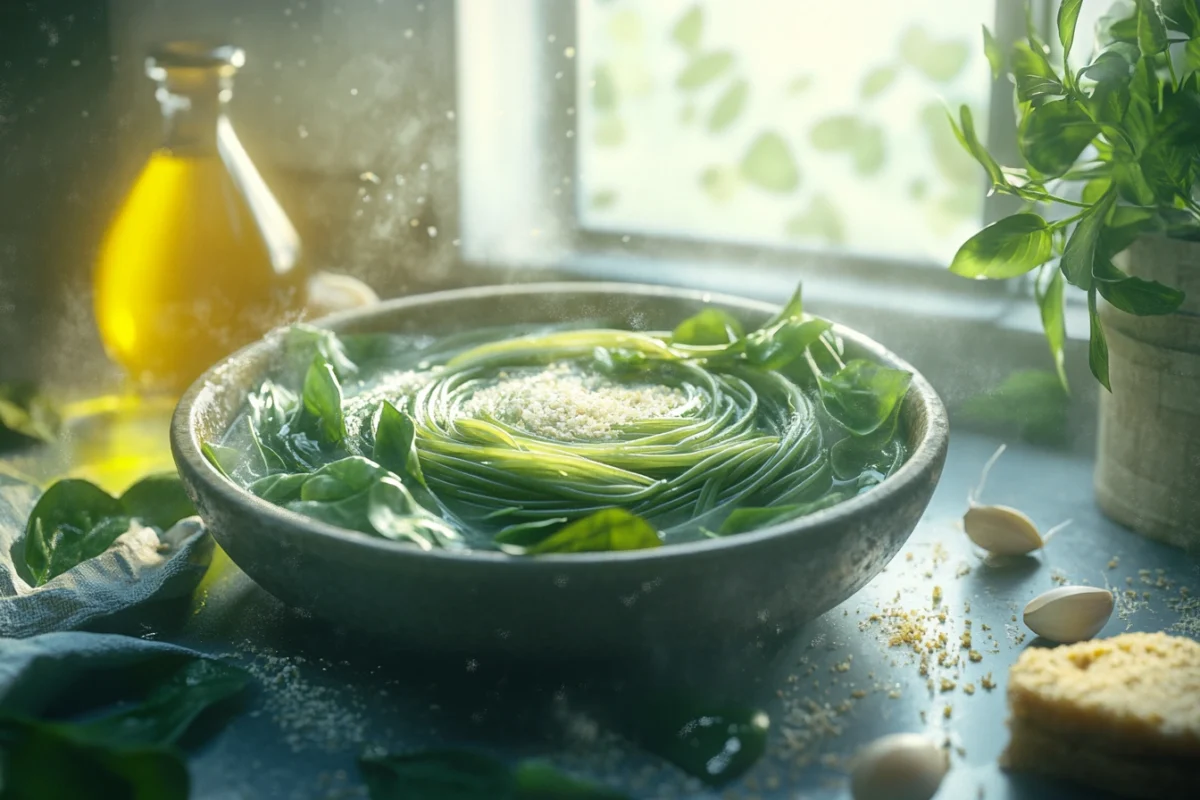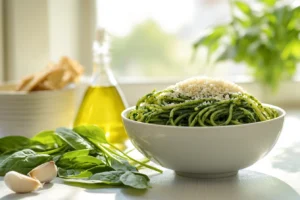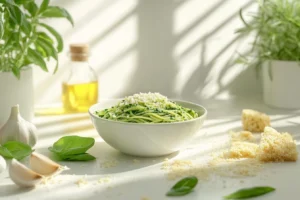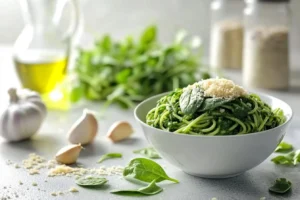This article will teach you how to make green spaghetti sensory play for kids, using simple, safe methods and materials. Explore fun ways to make colorful spaghetti at home.
How Do You Make Green Spaghetti Sensory Play? Easy Steps
Making green spaghetti sensory play is a fantastic way to engage children’s senses. Sensory play helps kids learn through touch and sight. This activity is simple and fun. It only requires a few items that are likely in your kitchen. Let’s get started with how to make colorful pasta. Furthermore, sensory activities are vital for child development. They assist in cognitive, emotional, and physical growth. Specifically, this green spaghetti activity is a great starting point.
For inspiration on fun food-related activities, check out our Corn Nuggets Guide: Recipes, Variations & Benefits.
Gathering Your Materials for Green Spaghetti Sensory Play
First, you need to gather a few essential materials. These items are easy to find. You’ll need spaghetti, some food coloring, oil and a large pot. Water is also an important component. Always use non-toxic food coloring. This way it is completely safe for little hands. Green food coloring will of course give the spaghetti its vibrant hue. Additionally, you might consider a colander for draining the pasta. A large bowl is also useful to mix everything together. Moreover, having all the materials ready beforehand streamlines the process.
Preparing the Spaghetti
Cooking the spaghetti is the first step in this process. Therefore, fill a large pot with water. Bring the water to a boil. Afterward, add the spaghetti to the boiling water. Follow package directions for cooking time. Do not overcook the pasta. It should be soft but not mushy. Once the spaghetti is cooked, drain it. Then rinse it under cold water to stop the cooking process. The cold water also helps to remove excess starch. Subsequently, rinsing the pasta prevents it from sticking together.
How To Dye Spaghetti for Sensory Activities
Dyeing the spaghetti is where the fun begins. Subsequently, take the drained spaghetti and place it in a large bowl. You can add one or two tablespoons of oil. The oil helps the color stick and prevents the spaghetti from clumping. Next, add the green food coloring. Use several drops, depending on how intense you want the color to be. Carefully mix everything. Make sure the spaghetti is evenly coated with color. Remember to wear gloves to keep your hands from staining! Accordingly, wearing gloves will keep your hands clean and mess-free.
Tips for Even Color Distribution
To get an even color, mix the spaghetti thoroughly. Therefore, use a large spoon or tongs to turn the spaghetti. Lift it from the bottom to the top. Ensure the food coloring is spread everywhere. Additionally, if the color is not dark enough, add a few more drops. Continue mixing until you reach your desired shade. For example, you can choose a bright, vibrant green or a softer, more subtle tone. Always start with less coloring and add more as needed. Therefore, you can always add more, but it is hard to take it away.
Alternatives to Food Coloring
If you do not want to use food coloring, there are alternatives. For instance, you could use natural dyes. Beet juice can create a pink color. Spinach juice can provide a green color. Turmeric can create a yellow hue. These alternatives are safe and natural. However, the colors may not be as vibrant as food coloring. To use them, add a small amount to the cooked pasta. Then, mix like you would with food coloring. The process is easy and fun. Ultimately, the chosen method depends on your preferences and needs. Furthermore, natural dyes can be a great option for those wanting more natural choices.
Sensory Play Ideas With Green Spaghetti
Now that you have vibrant green spaghetti, it is time for some fun! There are numerous ways to use this sensory material. For example, children can use their hands to explore the texture. They can also use spoons or small containers to move the spaghetti around. This is a great way to develop fine motor skills. Furthermore, you can hide small toys in the pasta for kids to find. It is a fun hide-and-seek game. Undoubtedly, these games enhance both fun and learning.
Using the Spaghetti for Fine Motor Skills
Fine motor skills are essential for children’s development. Playing with spaghetti helps kids improve their hand-eye coordination. Additionally, it strengthens the small muscles in their hands. For example, they can practice using tongs. This improves their grip and dexterity. They can also pinch the spaghetti with their fingers. These actions support their fine motor skills. This kind of practice is helpful for writing and other tasks. Consequently, these skills will aid them in their future academic endeavors.
Creative Sensory Play Activities
Green spaghetti can also be used for creative activities. Therefore, children can create “spaghetti art” on a tray. They can arrange it in different shapes. Also, they can use cookie cutters to make designs. Additionally, you can add small plastic animals to the sensory bin. This allows for imaginative play. They can make a pasta zoo or a monster lair. There are numerous possibilities. The only limit is their imagination. In addition, you could incorporate storytelling to add depth to their play.
How Do You Make Green Spaghetti Sensory Play? Safety First
When doing any sensory play activity, safety is the top priority. For instance, always supervise children while they play. Do not let them put the spaghetti in their mouths. Although the materials are non-toxic, it’s not meant to be eaten. Keep the pasta away from small children. Consider using a high chair or a play mat to contain the mess. This helps make cleanup easier. Accordingly, keeping children safe is of utmost importance.
Keeping the Play Area Clean
Playing with spaghetti can be a bit messy. Therefore, it is wise to prepare for clean up. Cover the area with an old sheet or a plastic mat. This protects your floor or table. Keep a damp cloth handy for quick cleanups. Additionally, keep a small bin ready for throwing away used spaghetti. Teach kids to help tidy up afterward. This encourages responsibility. It also shows them that cleanup is part of play. Moreover, teaching them to clean up can be a valuable life skill.
Proper Storage of Leftover Spaghetti
If you have any leftover green sensory spaghetti, store it properly. Put it in a sealed container. Keep it in the refrigerator for up to a day. After that, discard it. It’s important to avoid using old pasta. It can become sticky and can potentially have bacteria. Also, make sure to check it before play, to be sure it is still safe. Do not reuse the same batch multiple times. Ultimately, using fresh pasta for each play session is the safest option.
How Do You Make Green Spaghetti Sensory Play? Tips and Tricks
To ensure the activity is successful, here are some tips. For example, make sure the spaghetti is not too hot. Cool it down with cold water before adding food coloring. Additionally, do not add too much oil, since that will make the spaghetti too slippery. Always monitor kids closely. This ensures they stay safe. Also, add different materials to the sensory bin, such as scoops, cups, and toys, for added play value. Furthermore, rotating the items keeps it engaging.
Enhancing the Sensory Experience
To enhance the sensory experience, add other materials. For instance, you can add smooth river stones, or soft pom-poms. These additional elements make the play more interesting. Moreover, you can add a few drops of essential oils, such as lemon or lavender, to the spaghetti to add a scent element. This makes the experience richer. However, avoid strong scents. Keep it gentle for little noses. These variations make play more engaging. Likewise, incorporating different textures and scents can stimulate their senses.
Dealing With Allergies
When planning any sensory activity, keep allergies in mind. Some children might be sensitive to certain food colorings. If you are unsure, test a small amount on their skin first. If your child has any known allergies, ensure all materials are safe. Always prioritize their health and well-being. Always talk to parents beforehand if you are unsure about allergies. Therefore, communication and caution are vital steps. In addition, consider using hypoallergenic materials as needed.
Extending the Play: Variations on a Theme
Once you’ve mastered the basic green spaghetti sensory play, you can start to experiment with variations. For instance, you can make rainbow spaghetti by using different food colors. Additionally, you can add glitter for a sparkly effect or use different types of pasta for varied textures. Some good examples are penne, rotini, or farfalle. Furthermore, adding a water component can create a more watery sensory experience. Always consider new ways to keep things engaging and fun! Moreover, you can theme the sensory bin to match different seasons or holidays. For example, you could use fall colors and add small pumpkin decorations. Subsequently, rotating themes and variations will keep things exciting.
Adding Educational Elements
Green spaghetti sensory play can also have educational value. You can integrate counting activities by hiding number cards in the pasta. Children can search for them and count the objects. Likewise, you can introduce color recognition by using different colored pasta and asking them to sort by color. Additionally, you can also introduce letter recognition by using letter-shaped pasta or hiding letter cards. Furthermore, these educational elements will add another dimension to playtime. Ultimately, you can turn play time into a learning opportunity.
How Do You Make Green Spaghetti Sensory Play? Engaging Multiple Senses
Engaging multiple senses at once can greatly enhance children’s learning and development. Green spaghetti mainly uses touch and sight, but you can incorporate more senses. For instance, you can add scented oils. Additionally, you can add musical elements by playing soft tunes in the background. Furthermore, consider adding sounds that match your theme, if you are doing a themed bin. Also, you can add different textures like crinkly paper or feathers to add an auditory and tactile dimension. Therefore, the more senses you engage, the more immersive the experience will be. In addition, you can create a calm area for sensory play using soft music and low lighting to engage the senses.
Troubleshooting Common Issues
Sometimes, things may not go as planned during sensory play. For example, the spaghetti may become too sticky or clump together. To fix this, add a bit more oil and mix again. Another example is the coloring may not be as vibrant as you want. Add more coloring, gradually until you reach the desired color. Additionally, if children are hesitant to participate, try modeling the play yourself. Demonstrate the fun and safety aspects of the activity. Finally, always adapt your approach based on each child’s needs and preferences. Indeed, flexibility is important when doing sensory play with children.
Adapting for Different Age Groups
Green spaghetti sensory play can be easily adapted for different age groups. For younger children, use larger pasta shapes and fewer small items to prevent choking. For older children, incorporate more complex elements like sorting and measuring. Furthermore, you can create a scientific experiment by observing how the color transfers to white paper when using wet pasta. Subsequently, tailoring the activity to each age group is important. Also, you can encourage kids to create their own games and activities.
The Benefits of Sensory Play
Sensory play, in general, provides numerous benefits for children. It supports cognitive development, as it allows children to explore cause and effect. It also helps improve fine and gross motor skills, through the manipulation of different materials. Furthermore, sensory play helps to develop problem-solving abilities. It encourages creativity and imaginative play. Moreover, it provides a calming and relaxing experience. Therefore, this activity is important for children’s development. Additionally, sensory play can help to reduce anxiety and stress in some children.
Conclusion
In conclusion, making green spaghetti sensory play is fun and easy. It is a fantastic way to engage kids while they learn. It uses simple materials from home. Always prioritize safety. Additionally, supervise kids while they play. This activity is a great way to develop fine motor skills. It also encourages creativity. Finally, remember that sensory play is about having fun and exploring. Have a fantastic time making and playing with your green spaghetti! Overall, this activity is beneficial for all. Indeed, sensory activities provide valuable learning experiences. Therefore, have fun trying new variations and ideas.
For parents interested in the nutritional aspect of green spaghetti, explore Is Green Spaghetti Healthier?.




